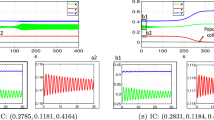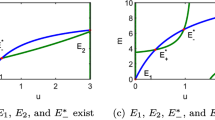Abstract
The existence of symmetric nonuniform solutions in nonlinear reaction-diffusion systems is examined. In the first part of the paper, we establish systematically the bifurcation diagram of small amplitude solutions in the vicinity of the two first bifurcation points. It is shown that:
-
i)
The system can adopt a stable symmetric solution (basic wave number 2) if the value of the bifurcation parameter is changed or if the initial polar structure (basic wave number 1) is sufficiently perturbed.
-
ii)
This behavior is independent of the particular reaction-diffusion model proposed and of the number of intermediate components (⩾2) involved.
In the second part of the paper, analogies are established between the possibilities offered by the bifurcation diagrams, involving only the two first primary branches, and the observation that in the early development of different organisms, appropriate experimental manipulations may switch the normal (polar) developmental pattern to a duplicate structure.
Similar content being viewed by others
References
Auchmuty, J. F. G. and Nicolis, G.: Bifurcation Analysis of Nonlinear Reaction-Diffusion Equations. I. Evolution and the Steady State Solutions. Bull. Math. Biology 37, 323–365 (1975)
Babloyantz, A., Hiernaux, J.: Models for Cell Differentiation and Generation of Polarity in Diffusion-Governed Morphogenetic Fields. Bull. Math. Biology 37, 637–657 (1975)
Brenner, M.: Cyclic AMP Gradient in Migrating Pseudoplasmodia of the Cellular Slime Mold Dictyostelium discoideum. J. Biol. Chem. 252, 4073–4077 (1977)
Child, C. M.: Patterns and Problems of Development. Chicago: The University of Chicago Press, 1941
Cooke, J., Zeeman, E. C.: A Clock and Wavefront Model for Control of the Number of Repeated Structures during Animal Morphogenesis. J. Theor. Biol. 58, 455–476 (1976)
Erneux, T.: Ph.D. Thesis, Université Libre de Bruxelles 1979
Fife, P. C.: Pattern Formation in Reacting and Diffusing Systems. J. Chem. Phys. 64, 554–564 (1976)
Fife, P. C.: On Modelling Pattern Formation by Activator-Inhibitor Systems. J. Math. Biol. 4, 353–362 (1977a)
Fife, P. C.: Stationary Patterns for Reaction-Diffusion Equations. Research Notes in Mathematics, 14, 81–122 (1977b)
French, V., Bryant, P. J., Bryant, S. V.: Pattern Regulation in Epimorphic Fields. Science, 193, 969–981 (1976)
Gierer, A.: Biological Features and Physical Concepts of Pattern Formation Exemplified by Hydra. Curr. Top. Develop. Biol. 11, 17–59 (1977)
Gierer, A., Meinhardt, H.: A Theory of Biological Pattern Formation. Kybernetik 12, 30–39 (1972)
Goldstein, R. A., Huerta, M. A., Nearing, J. C.: Secondary Bifurcation near Multiple Eigenvalues. To appear (1979)
Goodwin, B. C.: Analytical Physiology of Cells and Developing Organisms. New York: Academic Press, 1976
Herschkowitz-Kaufman: Bifurcation Analysis of Nonlinear Reaction-Diffusion Equations. II. Steady State Solutions and Comparison with Numerical Simulations. Bull. Math. Biol. 37, 589–636 (1975)
Hiernaux, J., Erneux, T.: Chemical Patterns in Circular Morphogenetic Fields. Bull. Math. Biol. 41, 461–468 (1979)
Jäckle, H., Kalthoff, K.: Photoreactivation of RNA in U.V. Irradiated Insect Eggs (Smittia Sp., Chironomidea, Diptera). I. Photosensitized Production and Light-Dependent Disappearance of Pyrimidine Dimers. Photochem. and Photobiol. 27, 309–315 (1978)
Kalthoff, K.: Action Spectra for U.V. Irradiation and Photoreversal of a Switch in the Developmental Program of the Egg of an Insect (Smittia). Photochem. and Photobiol. 18, 355–364 (1973)
Kalthoff, K.: Specification of the Antero-Posterior Body Pattern in Insect Eggs. In: Insect Development (P. A. Lawrence, ed.) pp. 53–75. Oxford: Blackwell, 1976
Kalthoff, K.: Pattern Formation in Early Insect Embryogenesis Data Calling for Modification of a Recent Model. J. Cell. Sci. 29, 1–15 (1978)
Kalthoff, K., Hanel, P., Zissler, D.: A Morphogenetic Determinant in the Anterior Pole of an Insect Egg (Smittia spec., Chiromidae, Diptera). Localization by Combined Centrifugation and Ultraviolet Irradiation. Dev. Biol. 55, 285–305 (1977)
Kandler-Singer, I., Kalthoff, K.: RNAse Sensitivity of an Anterior Morphogenetic Determinant in an Insect Egg (Smittia sp., Chiromidea, Diptera). Proc. Nat. Acad. Sci. U.S.A. 73, 3739–3743 (1976)
Kauffman, S. A., Shymko, R. M., Trabert, K.: Control of Sequential Compartment Formation in Drosophilia. Science 199, 259–270 (1978)
Keener, J. P.: Secondary Bifurcations in Nonlinear Diffusion Reaction Equations. Stud. Appl. Math. 55, 187–211 (1976)
Keener, J. P.: On the Validity of the Two-Timing Method for Large Times. SIAM J. Math. Anal. 8, 1067–1091 (1977)
Keener, J. P.: Activators and Inhibitors in Pattern Formation. Stud. Appl. Math. 59, 1–23 (1978)
Kubicek, M. Rýzler, V., Marek, M.: Spatial Structures in a Reaction-Diffusion SystemDetailed Analysis of the ‘Brusselator’. Bioph. Chem. 8, 235–246 (1978)
Løvtrup, S., Landström, U., Løvtrup-Rein, H.: Polarities, Cell Differentiation and Primary Induction in the Amphibian Embryo. Biol. Rev. 53, 1–42 (1978)
McCabe, J. A., Parker, B. W.: Evidence for a Gradient of a Morphogenetic Substance in the Developing Limb. Develop. Biol. 54, 297–303 (1976)
Mahar, T. J., Matkowsky, B. J.: A Model Biochemical Reaction Exhibiting Secondary Bifurcation. SIAM J. Appl. Math. 32, 394–404 (1977)
Matkowsky, B. J., Reiss, E. L.: Singular Perturbation of Bifurcations. SIAM J. Appl. Math. 33, 230–255 (1977)
Meinhardt, H.: A Model of Pattern Formation in Insect Embryogenesis. J. Cell. Sci. 23, 117–139 (1977)
Meinhardt, H.: Models for the Ontogenic Development of Higher Organisms. Rev. Physiol. Biochem. Pharmacol. 80, 47–103 (1978)
Nicolis, G., Prigogine, I.: ‘Self-Organization in Nonequilibrium Systems’. Wiley, 1977
Nicolis, G., Auchmuty, J. F. G.: Dissipative Structures, Catastrophe Theory and Pattern Formation: a Bifurcation Analysis. Proc. Nat. Acad. Sci. U.S.A. 71, 2748–2751 (1974)
Nieuwkoop, P. D.: Origin and Establishment of Embryonic Polar Axis in Amphibien Development. Curr. Top. in Develop. Biol. 11, 115–132 (1977)
Othmer, H. G.: Current Problems in Pattern Formation. Lectures on Mathematics in the Life Sciences. Vol. 9, 57–85 (1977)
Sander, K.: Pattern Specification in the Insect Embryo. In: ‘Cell Patterning’. Ciba Foundation Symp. 29. Amsterdam: Elsevier, 1975
Sander, K.: Specification of the Basic Body Pattern in Insect Embryogenesis. Adv. in Insect Physiology 12, 125–238 (1976)
Saunders, J. W., Gasseling, M. T.: Ectodermal-Mesenchymal Interaction in the Origin of Limb Symmetry. In: Epithelial-Mesenchymal Interactions (R. Fleischmayer and R. E. Billingham, eds.) 78–98. Baltimore: Williams and Wilkins, 1968
Schmidt, O., Zissler, D., Sander, K., Kalthoff, K.: Switch in Pattern Formation after Puncturing the Anterior Pole of Smittia Eggs (Chiromidae, Diptera). Develop. Biol. 46, 216–221 (1975)
Shaeffer, D., Golubitsky, M.: Bifurcation Analysis near a Double Eigenvalue of a Model Chemical Reaction. In press (1979)
Slack, J. M. W.: Determination of Anteroposterior Polarity in the Axolotl Forelimb by an Interaction between Limb and Flank Rudiments. J. Embryol. Exp. Morph. 39, 151–168 (1977a)
Slack, J. M. W.: Determination of Anteroposterior Pattern in Axolotl Forelimb by a Smoothly Graded Signal. J. Embryol. Exp. Morph. 39, 169–182 (1977b)
Smith, J. C., Tickle, C., Wolpert, L.: Alternation of Positional Signalling in the Chick Limb by High Doses of γ-radiation. Nature 272, 612–613 (1978)
Tickle, C., Summerbell, D., Wolpert, L.: Positional Signalling and Specification of Digits in Chick Limb Morphogenesis. Nature 254, 199–202 (1975)
Wall, R.: Physiological Gradients in Developments — A Possible Role for Messenger Ribonucleoprotein. Adv. in Morphogenesis 10, 41–114 (1973)
Webster, G.: Morphogenesis and Pattern Formation in Hydroids. Biol. Rev. 46, 1–46 (1971)
Wolpert, L.: Positional Information and the Spatial Pattern of Cellular Differentiation. J. Theor. Biol. 25, 1–47 (1969)
Wolpert, L.: Pattern Formation in Biological Development. Scientific American. October 1978
Author information
Authors and Affiliations
Rights and permissions
About this article
Cite this article
Erneux, T., Hiernaux, J. Transition from polar to duplicate patterns. J. Math. Biology 9, 193–211 (1980). https://doi.org/10.1007/BF00276025
Received:
Issue Date:
DOI: https://doi.org/10.1007/BF00276025




